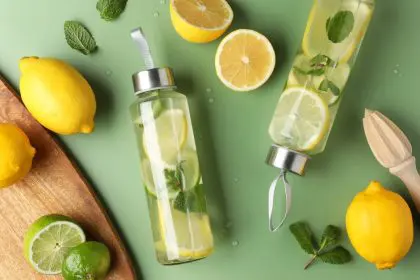You’ve probably spent a small fortune on trendy wellness shots promising to boost your immunity, fight inflammation, and basically turn you into a glowing health goddess. But what if the most powerful wellness ingredient has been sitting in plain sight, disguised as a pretty flower that most people only associate with tropical vacation drinks and herbal tea blends?
Hibiscus isn’t just another Instagram-worthy wellness trend looking for its moment in the spotlight. This vibrant flower has been quietly delivering serious health benefits for centuries, packed with compounds that could make your expensive green juice shots look like overpriced sugar water. The deep red color that makes hibiscus so visually appealing is actually a sign of the potent antioxidants that give this flower its impressive therapeutic potential.
The beauty of hibiscus as a wellness ingredient is that it’s been hiding in plain sight all along. While wellness influencers have been hyping exotic superfoods with names you can’t pronounce, hibiscus has been delivering measurable health benefits without the premium price tag or complicated sourcing stories that usually come with superfood status.
The antioxidant levels that put berries to shame
Hibiscus contains higher levels of antioxidants than many of the fruits and vegetables that get all the superfood attention, with particularly high concentrations of anthocyanins, flavonoids, and phenolic compounds that give it serious disease-fighting potential. The ORAC (Oxygen Radical Absorbance Capacity) value of hibiscus extract is comparable to or higher than blueberries, which have long been considered the gold standard for antioxidant-rich foods.
These antioxidants work by neutralizing free radicals that contribute to cellular damage, inflammation, and aging processes throughout your body. Unlike synthetic antioxidant supplements that can sometimes create imbalances, the complex mixture of antioxidants in hibiscus works synergistically to provide comprehensive cellular protection.
The bioavailability of hibiscus antioxidants is particularly impressive, meaning your body can actually absorb and use these compounds effectively rather than just passing them through your system. This makes hibiscus potentially more beneficial than antioxidant supplements that look good on paper but don’t translate into real-world health benefits.
The blood pressure benefits that rival prescription medications
Multiple clinical studies have shown that hibiscus can lower blood pressure as effectively as some prescription medications, with some research indicating reductions of 10-15 points in systolic blood pressure after just a few weeks of regular consumption. This makes hibiscus one of the most evidence-based natural approaches to cardiovascular health management.
The mechanism behind hibiscus’s blood pressure effects involves multiple pathways, including natural ACE inhibition, improved arterial flexibility, and diuretic effects that help reduce fluid retention. Unlike pharmaceutical approaches that typically target single pathways, hibiscus provides comprehensive cardiovascular support through multiple biological mechanisms.
What’s particularly impressive is that these blood pressure benefits occur at doses that are easily achievable through regular consumption of hibiscus tea or concentrated extracts. You don’t need megadoses or expensive supplements to see measurable cardiovascular improvements from adding hibiscus to your wellness routine.
The weight management effects nobody talks about
Hibiscus contains compounds that can help block the absorption of carbohydrates and support healthy metabolism, potentially making it a valuable addition to weight management strategies. Some research suggests that hibiscus extract can inhibit amylase, an enzyme responsible for breaking down starches, which could help reduce the caloric impact of carbohydrate-rich meals.
The flower also appears to support healthy lipid metabolism, helping your body process fats more effectively and potentially reducing the accumulation of visceral fat. These effects aren’t dramatic enough to replace proper diet and exercise, but they could provide meaningful support for people working toward weight management goals.
Unlike stimulant-based weight loss supplements that can cause jitters or crash effects, hibiscus provides gentle metabolic support without disrupting your energy levels or sleep patterns. This makes it a sustainable addition to long-term wellness routines rather than a quick fix that becomes unsustainable over time.
The liver detox support that actually works
Your liver is constantly working to process toxins, metabolize nutrients, and maintain overall health, and hibiscus provides specific compounds that support optimal liver function. The antioxidants in hibiscus help protect liver cells from oxidative damage while supporting the liver’s natural detoxification processes.
Unlike harsh detox products that can stress your liver while claiming to cleanse it, hibiscus provides gentle support that works with your body’s natural detoxification systems. This makes it particularly valuable for people dealing with environmental toxin exposure, medication side effects, or lifestyle factors that put additional stress on liver function.
The hepatoprotective effects of hibiscus have been demonstrated in research, showing that regular consumption can help maintain healthy liver enzyme levels and support overall hepatic function. This is particularly relevant given the increasing toxic load that modern lifestyles place on our detoxification systems.
The blood sugar regulation that beats expensive supplements
Hibiscus has been shown to help regulate blood sugar levels and improve insulin sensitivity, making it potentially valuable for people managing diabetes or prediabetes. The compounds in hibiscus appear to slow the absorption of sugars and support more stable blood glucose levels after meals.
This blood sugar regulation happens through multiple mechanisms, including effects on carbohydrate digestion, glucose absorption, and insulin signaling pathways. The result is more stable energy levels throughout the day and reduced risk of the blood sugar spikes and crashes that contribute to cravings and metabolic dysfunction.
For people without diabetes, the blood sugar stabilizing effects of hibiscus can still provide benefits in terms of sustained energy, reduced cravings, and better metabolic health. This makes hibiscus valuable for anyone interested in optimizing their metabolic function and energy stability.
The preparation methods that maximize benefits
Getting the most benefit from hibiscus requires understanding how to prepare it properly to extract the maximum amount of active compounds. Hot water extraction, as used in traditional tea preparation, is effective for extracting many of the beneficial compounds, but cold brewing can preserve heat-sensitive nutrients that might be destroyed by high temperatures.
Concentrated hibiscus extracts and powders can provide higher doses of active compounds than traditional tea preparations, making them potentially more effective for therapeutic purposes. However, the whole flower preparations provide a broader spectrum of compounds that work together synergistically.
The timing of hibiscus consumption can also affect its benefits, with some research suggesting that consuming hibiscus before meals may enhance its blood sugar and weight management effects. Experimenting with different preparation methods and timing can help you optimize the benefits for your specific health goals.
The quality factors that determine effectiveness
Not all hibiscus products are created equal, and the source, processing methods, and storage conditions can significantly affect the potency and effectiveness of hibiscus preparations. Organic hibiscus from reputable sources typically provides higher levels of beneficial compounds than conventionally grown varieties.
The color intensity of hibiscus preparations is often a good indicator of antioxidant content, with deeper red colors generally indicating higher concentrations of beneficial anthocyanins. However, processing methods and storage conditions can affect both color and potency, making it important to choose products from companies that prioritize quality and proper handling.
Fresh hibiscus flowers, when available, can provide optimal nutrient content, but properly dried and stored hibiscus can retain most of its beneficial compounds for extended periods. The key is choosing products that have been processed and stored in ways that preserve the delicate compounds that provide hibiscus’s health benefits.
Making hibiscus your go-to wellness shot
Incorporating hibiscus into your wellness routine doesn’t require expensive products or complicated preparations. A simple hibiscus tea can provide significant health benefits, while concentrated preparations can deliver therapeutic doses of active compounds for specific health goals.
For people interested in replacing expensive wellness shots with more affordable alternatives, hibiscus offers impressive benefits at a fraction of the cost. The flower can be purchased in bulk, prepared at home, and customized to your taste preferences while providing measurable health benefits.
The key to success with hibiscus is consistency rather than intensity. Regular, moderate consumption is more beneficial than occasional large doses, and the cumulative effects of hibiscus build over time with consistent use. This makes it an ideal addition to daily wellness routines focused on long-term health optimization rather than quick fixes.















